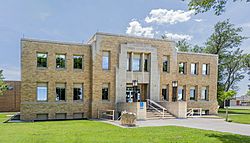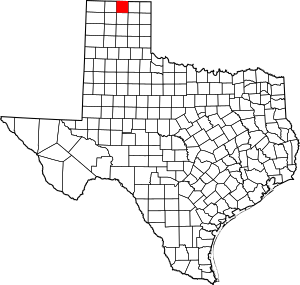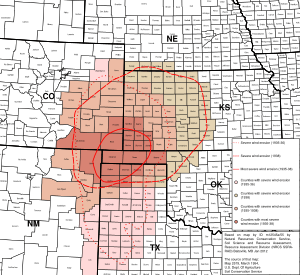Hansford County, Texas facts for kids
Quick facts for kids
Hansford County
|
|
|---|---|

Hansford County Courthouse in Spearman
|
|

Location within the U.S. state of Texas
|
|
 Texas's location within the U.S. |
|
| Country | |
| State | |
| Founded | 1889 |
| Named for | John M. Hansford |
| Seat | Spearman |
| Largest city | Spearman |
| Area | |
| • Total | 920 sq mi (2,400 km2) |
| • Land | 920 sq mi (2,400 km2) |
| • Water | 0.6 sq mi (2 km2) 0.06% |
| Population
(2020)
|
|
| • Total | 5,285 |
| • Density | 5.74/sq mi (2.218/km2) |
| Time zone | UTC−6 (Central) |
| • Summer (DST) | UTC−5 (CDT) |
| Congressional district | 13th |

Hansford County is a county located in the state of Texas. It's in the northern part of the Texas Panhandle. In 2020, about 5,285 people lived there. The main town and county seat is Spearman. Hansford County was officially created in 1876 and started operating in 1889. It is named after John M. Hansford, who was an important judge and politician in Texas.
History of Hansford County
Early Native American Life
In 1873, two brothers from England, James and Arthur Cator, came to Kansas looking for ways to make money. They became buffalo hunters. They set up a camp called Zulu Stockade near the North Palo Duro Creek. This camp was important for their hunting activities.
Hunting too many buffalo caused problems between Native American tribes and the new settlers. The buffalo were a main food source for the tribes.
The Second Battle of Adobe Walls
A big battle happened in 1874 in a nearby county. It was called the Second Battle of Adobe Walls. This battle led to the Red River War. Buffalo hunters tried to rebuild an old fort called Adobe Walls. The Comanche, Cheyenne, Arapaho, and Kiowa tribes saw this fort and the hunting of buffalo as a threat.
A Comanche medicine man named Isa-tai told his people they would win and be safe from bullets. Quanah Parker led hundreds of warriors in an attack on the fort. But the buffalo hunters fought back strongly. They forced the Native Americans to leave. The Red River War (1874-1875) was a military effort by the United States Army. Its goal was to move Native American tribes in Texas to reservations. This would open up the land for more settlers.
Hansford County's Establishment and Growth
The Texas government officially created Hansford County in 1876. It was formed from parts of Young and Bexar Counties. The county government started in 1889. The town of Hansford was the first county seat.
Ranches and Settlements
In the early days, large ranches covered Hansford County and nearby areas. By 1890, there were only 23 ranches in the county. In 1876, Thomas Sherman Bugbee started the Quarter Circle T Ranch. The Scissors Ranch began in 1878. It was named for its brand, which looked like scissors.
The Turkey Track Ranch was started by Richard E. McNalty. Later, a Scottish man named James M. Coburn bought several of these big ranches. He formed the Hansford Land and Cattle Company.
In 1887, Hansford became a stop for stagecoaches. This was on the old trail between Tascosa and Dodge City.
New Communities and Railways
In 1909, Anders L. Mordt helped Norwegian farmers settle in the northern part of the county. They created a community called Oslo.
By 1920, Hansford County had 221 farms and ranches. The North Texas and Santa Fe Railway reached Spearman in the same year. By 1929, Spearman became the new county seat. Another railway, the Chicago, Rock Island and Gulf Railway, built tracks south in the 1920s. This led to Gruver becoming the second-largest town. In 1931, the Santa Fe and Rock Island railways connected near Morse.
Highways and farm roads were built across the county from the 1920s to the 1940s. This made travel much easier.
Oil Discovery
Oil was found in Hansford County in 1937. By the end of 1974, over 38 million barrels of oil had been taken from the county's land. By the 1980s, Hansford County had a strong economy. It was based on farming, oil, and transportation.
Geography
Hansford County covers a total area of 920 square miles. Almost all of this is land. Only about 0.6 square miles (0.06%) is covered by water.
Major Highways
Neighboring Counties
Hansford County shares borders with these counties:
- Texas County, Oklahoma (north)
- Ochiltree County (east)
- Roberts County (southeast)
- Hutchinson County (south)
- Sherman County (west)
Population Information
| Historical population | |||
|---|---|---|---|
| Census | Pop. | %± | |
| 1880 | 18 | — | |
| 1890 | 133 | 638.9% | |
| 1900 | 167 | 25.6% | |
| 1910 | 935 | 459.9% | |
| 1920 | 1,354 | 44.8% | |
| 1930 | 3,548 | 162.0% | |
| 1940 | 2,783 | −21.6% | |
| 1950 | 4,202 | 51.0% | |
| 1960 | 6,208 | 47.7% | |
| 1970 | 6,351 | 2.3% | |
| 1980 | 6,209 | −2.2% | |
| 1990 | 5,848 | −5.8% | |
| 2000 | 5,369 | −8.2% | |
| 2010 | 5,613 | 4.5% | |
| 2020 | 5,285 | −5.8% | |
| U.S. Decennial Census 1850–2010 2010 2020 |
|||
In 2000, Hansford County had 5,369 people living in 2,005 households. About 1,489 of these were families. The county had about 6 people per square mile.
Many households (36.9%) had children under 18 living with them. Most households (65%) were married couples. About 24% of all households were single individuals. About 12.4% of households had someone aged 65 or older living alone.
The average household had 2.63 people. The average family had 3.14 people.
The population's age breakdown was:
- 29.3% were under 18 years old.
- 6.8% were 18 to 24 years old.
- 26.3% were 25 to 44 years old.
- 22.3% were 45 to 64 years old.
- 15.2% were 65 years or older.
The average age in the county was 36 years.
In terms of different backgrounds in 2000:
- About 79.88% of people were White.
- About 0.75% were Native American.
- About 17.47% were from other races.
- About 31.48% of the population was Hispanic or Latino.
The average income for a household in the county was $35,438. For a family, it was $40,281. About 16.4% of the population lived below the poverty line. This included 22.6% of those under 18.
Communities
Cities
Census-designated place
See also
 In Spanish: Condado de Hansford para niños
In Spanish: Condado de Hansford para niños

